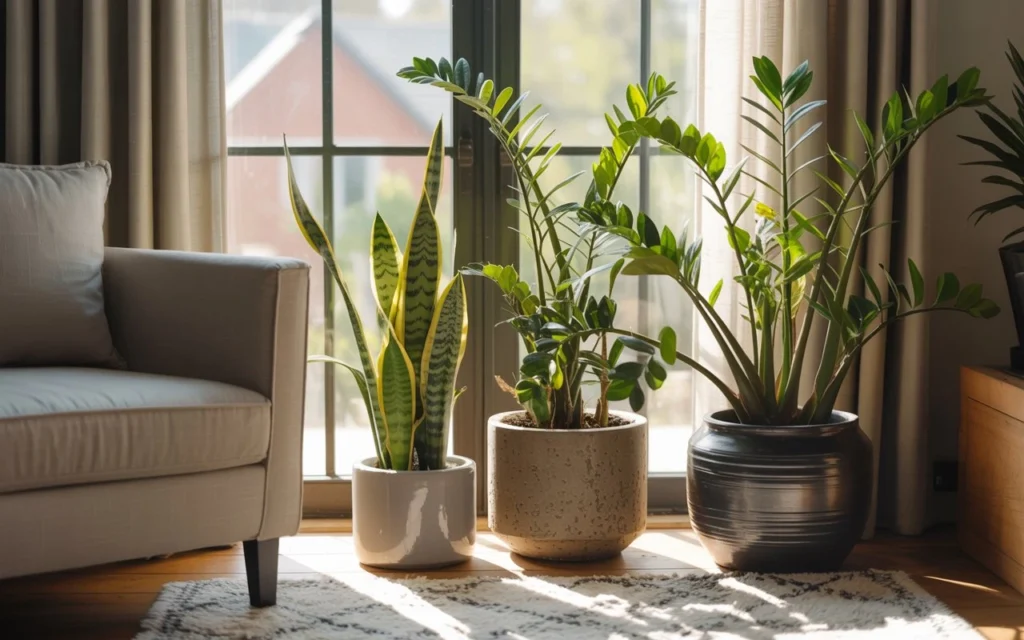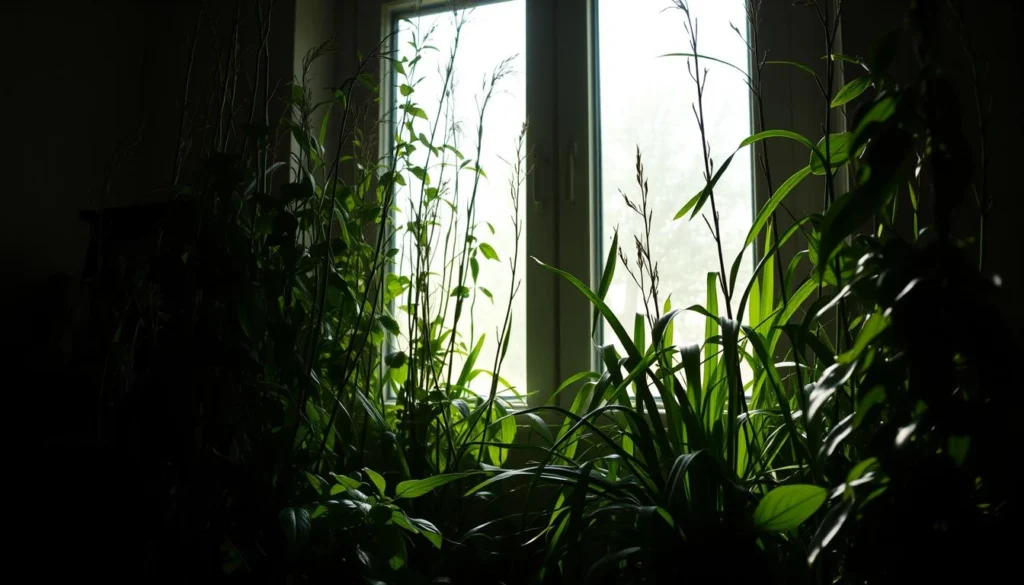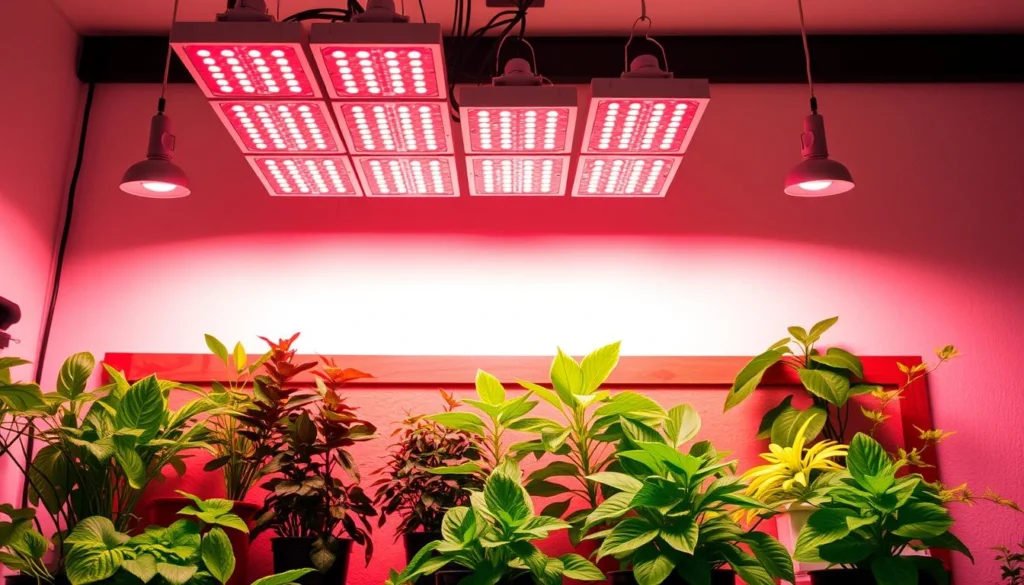
Can you really keep your houseplants thriving in a room with little to no natural light? Yes, thanks to LED plant grow lights. Many of us struggle to maintain a lush plant collection due to insufficient lighting. But, supplemental lighting can be a game-changer.
Having a room or entire home with limited natural light doesn’t mean you have to give up on your dream of having a thriving indoor garden. Grow lights for indoor plants offer a reliable solution. They allow you to create an ideal environment for your plants to flourish year-round.
This guide will walk you through the basics of using grow lights. You’ll learn how to choose the right type and set them up effectively. Whether you’re a seasoned gardener or just starting out, you’ll discover how to harness the power of supplemental lighting. This will keep your plants healthy and vibrant.
Understanding Why You Need Grow Lights for Indoor Plants
To keep your indoor plants healthy, it’s key to know about grow lights. Indoor plants love sunlight but often lack it indoors.
The Science Behind Plant Light Requirements
Plants need light to grow. They use light to make food. The type and amount of light matter a lot.
Most plants need a mix of blue, red, and green light. Blue helps leaves grow, and red helps with flowers and fruits.
Grow lights give plants the light they need. There are many types, like LED, fluorescent, and HID. LED grow lights are good because they save energy and can match different plant needs.
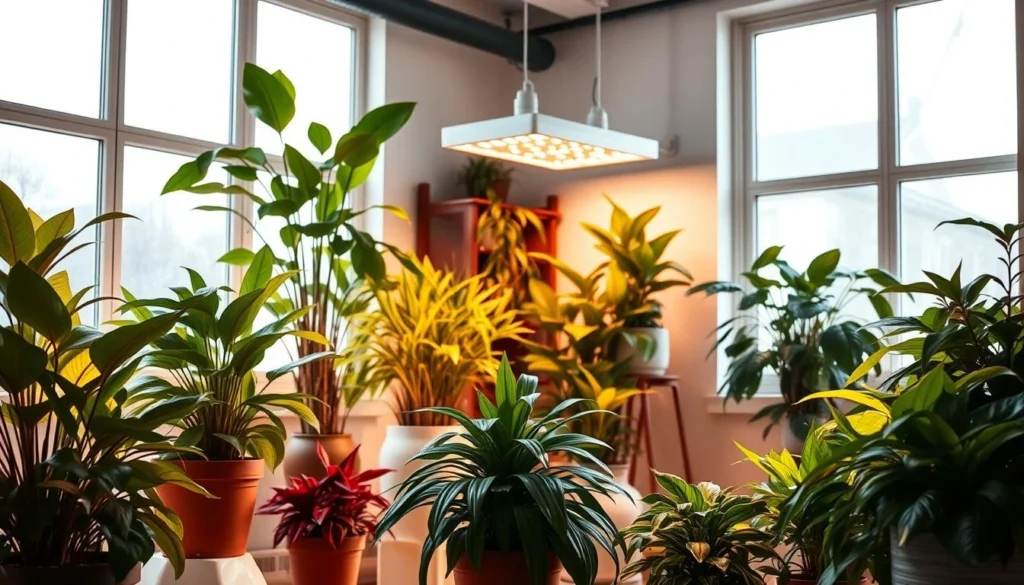
Signs Your Indoor Plants Need More Light
When plants don’t get enough light, they show signs. Look for:
- Slow growth or stunted development
- Pale or discolored leaves
- Leggy stems as the plant stretches towards the light source
- Failure to produce flowers or fruits
Seeing these signs means it’s time for more light. This helps your plants grow well.
Benefits of Using Supplemental Lighting
Grow lights are great for indoor plants. They offer:
- Enhanced Growth: More light means better photosynthesis and healthier plants.
- Increased Yield: Right lighting can make plants produce more fruits or flowers.
- Flexibility: Grow lights let you garden anywhere, not just where it’s sunny.
Knowing these benefits helps you create the best space for your plants.
Types of Grow Lights and Their Specific Applications
Choosing the right grow light for your indoor plants can be tough. But knowing what each type is best for makes it easier. There are many grow lights out there, each with its own strengths and weaknesses.
LED Grow Lights: Energy-Efficient and Versatile
LED grow lights are a favorite among indoor gardeners. They use less energy and are very flexible. They give plants a special grow light spectrum for plants that helps them grow well.
LED lights can be adjusted to fit the needs of different plants. This makes them great for many types of plants.
Some key benefits of LED grow lights include:
- They use less energy, saving you money on electricity
- They last a long time, so you don’t have to replace them often
- You can change the spectrum to match what different plants need
- They don’t get very hot, which helps prevent overheating
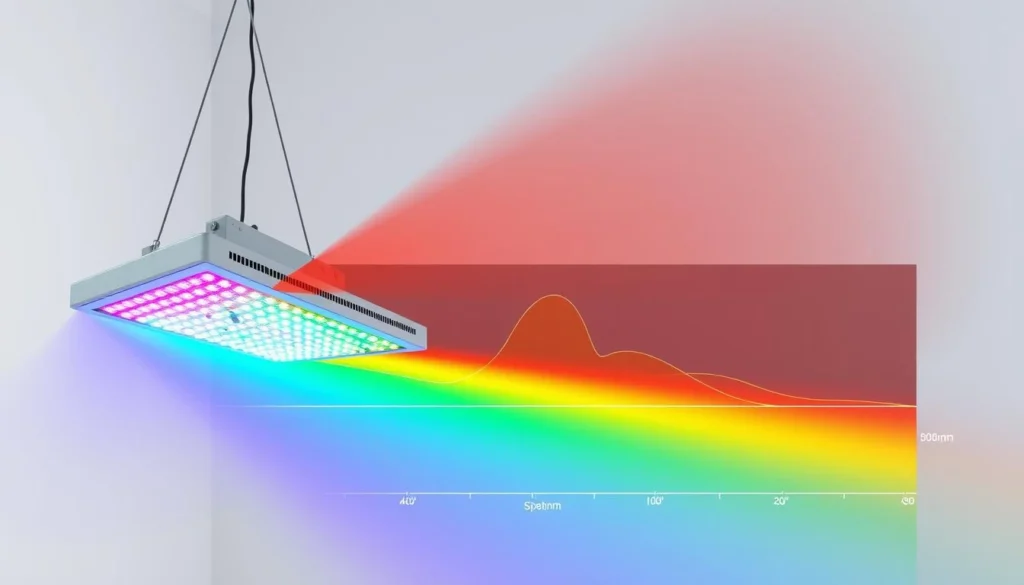
Fluorescent Options: T5, T8, and CFLs
Fluorescent grow lights, like T5, T8, and CFLs, are also good for indoor gardening. They are cheaper than LEDs and still help plants grow. But they use more energy and don’t last as long.
Fluorescent lights work well for:
- Young plants that need gentle light
- Plants that don’t need a lot of light, like leafy greens
- Adding extra light in places where it’s hard to get natural light
HID Lights: When and Why to Use Them
HID (High-Intensity Discharge) lights are very bright and good for plants that need lots of light. These plants are often fruiting or flowering types. But HID lights get hot and use a lot of energy, more than LEDs.
Use HID lights if:
- You’re growing plants that really need a lot of light
- You have a place that’s well-ventilated to handle the heat
- You prefer a more traditional grow light
When picking grow lights for your indoor plants, think about energy use, spectrum, and how bright they are. The best indoor plant grow lights usually offer a good balance of these things for the best growth.
Setting Up Your Grow Lights for Indoor Plants
Grow lights can greatly improve your indoor plants’ health and growth. You need to think about a few things. These include the distance between the lights and plants, the area covered, and the light schedule.
Determining the Correct Distance and Coverage
The distance between your grow lights and plants is key. They should be above your plants to mimic sunlight and ensure even light. The exact distance depends on the grow light type and your plants’ needs.
For example, LED lights can be closer because they don’t get hot. HID lights need more space because they do. Start with 12-18 inches for LED lights and adjust as needed.
Creating an Effective Light Schedule
Make a light schedule that matches natural daylight. Most plants need 12-14 hours of light daily. But, this can change based on the plant and its growth stage.
Using a timer helps keep the light schedule consistent. It ensures your plants get the right light and saves energy by turning off lights when not needed.
Installation Tips and Safety Considerations
When setting up your grow lights, make sure they’re secure to avoid accidents. Keep cords and lights dry to avoid electrical shock. Always follow the manufacturer’s instructions for setup and care.
| Grow Light Type | Recommended Distance | Energy Efficiency |
|---|---|---|
| LED Grow Lights | 12-18 inches | High |
| HID Grow Lights | 24-36 inches | Medium |
| Fluorescent Grow Lights | 6-12 inches | High |
Using energy-efficient grow lights like LEDs saves energy. They also give your plants the full spectrum light they need. With the right setup, you can create a perfect environment for your indoor plants to grow well.
Optimizing Growth with the Right Light Strategy
To get the most out of your indoor plants, it’s crucial to understand how to optimize their growth with the right light strategy. This involves understanding the specific lighting needs of your plants at different stages of their growth and adjusting your grow light setup accordingly.
Matching Light Spectrum to Growth Stages
Plants require different wavelengths of light at various stages of their growth. Blue light promotes vegetative growth, encouraging your plants to develop healthy leaves and stems. On the other hand, red light encourages flowering and fruiting, which is essential for plants that produce flowers or fruits.
Using full-spectrum lights can provide a balanced spectrum that suits most plants. These lights mimic natural daylight and can support your plants throughout their growth cycle.
- Use blue light during the vegetative stage to promote leaf growth.
- Switch to red light during the flowering stage to encourage blooming.
- Consider full-spectrum lights for a versatile lighting solution.
Adjusting for Different Plant Types
Different plants have unique lighting requirements. Understanding these needs is crucial for optimizing your grow light setup.
Flowering Plants vs. Foliage Plants
Flowering plants require more intense light, particularly in the red spectrum, to promote blooming. Foliage plants, on the other hand, thrive under bluer light, which encourages leaf growth.
Herbs, Vegetables, and Succulents
Herbs and vegetables often require a lot of light, especially when they’re producing fruits or flowers. Succulents generally need bright light but can be sensitive to intense direct light, so it’s essential to balance their lighting needs.
Measuring Light Intensity and Making Adjustments
Measuring the light intensity your plants receive is crucial for making necessary adjustments. You can use a light meter to determine the Photosynthetic Active Radiation (PAR) your plants are exposed to.
- Use a light meter to measure PAR.
- Adjust the distance between your plants and the grow lights based on the reading.
- Monitor your plants’ response and adjust the light spectrum or intensity as needed.
By fine-tuning your grow light setup and adjusting it according to your plants’ needs, you can significantly enhance their growth and productivity.
Read More :
Best Indoor Plants for Dark Rooms
Conclusion
Understanding your indoor plants’ light needs is key to a thriving garden. The right grow lights can make your plants grow well. Whether you choose LED, fluorescent, or HID lights, pick the best for your plants.
This guide has given you the tools to pick the best grow lights. You can now use them to help your plants grow. Follow the steps to make your indoor garden flourish, even with little natural light.
Remember, the right grow lights are crucial for your indoor garden. Try different light setups and adjust as needed. With the right tools and patience, your garden will soon be vibrant and healthy.
FAQ
What are the best grow lights for indoor gardening?
The best grow lights for indoor gardening vary based on your needs. LED grow lights are popular for their energy efficiency and versatility. Full spectrum LED grow lights are especially good for healthy plant growth.
How do I determine the correct distance for my grow lights?
The right distance for your grow lights depends on the light type and intensity, and your plants’ needs. LED lights should be 12-24 inches from plants. HID lights need 24-36 inches.
What is the ideal light spectrum for indoor plants?
The best light spectrum for indoor plants changes with growth stage and plant type. A full spectrum light with blue, red, and green is usually best. It helps plants grow well.
How long should I run my grow lights each day?
How long to run grow lights varies by plant needs. Most plants need 12-18 hours of light daily. Some need more or less. Check your plants’ needs for the best light schedule.
Can I use regular household lights as grow lights?
Household lights can give plants some light, but they’re not a good substitute for grow lights. Grow lights are made to give plants the right intensity and spectrum for growth.
Are energy-efficient grow lights worth the investment?
Yes, energy-efficient grow lights like LEDs are worth it. They save energy and create a better environment for your plants.
How do I measure the light intensity of my grow lights?
Use a light meter to measure your grow lights’ intensity. It helps you see if your plants are getting enough light and adjust as needed.
